Video Description
The innovation process for digital health is an iterative cycle for technological solutions classified into 5 main activity processes beginning from the identification of the healthcare problem, research, digital solution, evaluating the solution to implementation in working clinical practices

Leverage data from electronic health records and other critical sources to create a streamlined care model that combines genomics, clinical analytics, care coordination, and care team collaboration with the capability to engage patients in a new, more impactful way
Engage with patients between visits, create dynamic care plans, and predict future patient risks to drive the shift from reactive to proactive care
Consolidate patient health histories, genomic data, and social and environmental data by leveraging machine intelligence to deliver tailored treatment decisions that accelerate patient outcomes
Ensure consistent, effective care and scale best practices across your organization by enabling seamless communication among caregivers anytime, anywhere
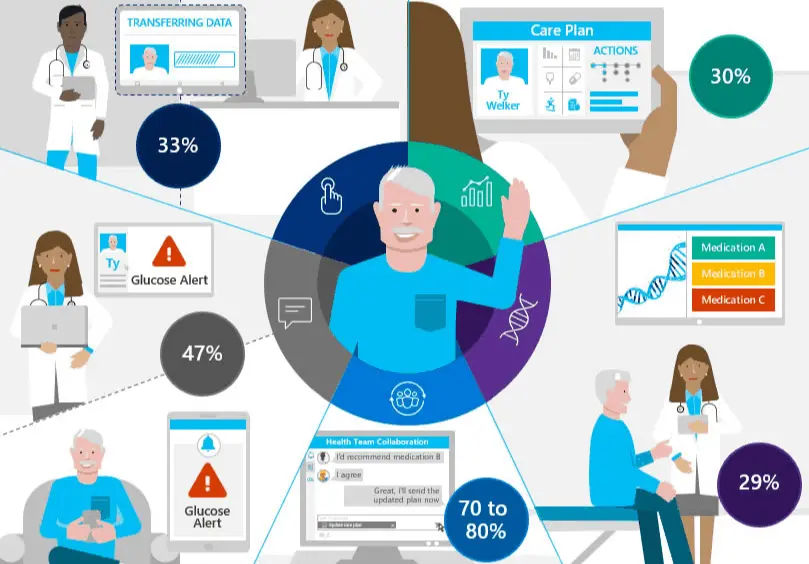
Build a unified care experience that fosters active patient involvement in the care plan
Create personalized care coordination experiences that orchestrate next best actions for each team member
Utilize advanced clinical analytics to predict health risks in your population, improve clinical outcomes, and optimize hospital operations
Enable collaborative relationships between patients and providers with enhanced patient engagement
Improve quality of care by empowering health team collaboration and communication in a compliant, secure environment
Leverage actionable insights from genomic data to make effective care decisions

The Patient Engagement solutions offer new ways for caregivers to connect with patients before, during, and after visits
These solutions make it easier to maintain contact with patients through apps, devices, and a trusted cloud environment.
By harnessing data through advanced analytics tools, address patients’ health issues before illness occurs, and reduce their interactions with providers.
Through an integrated health platform, transform acute, community, and ambulatory settings for patients, improving care and lowering costs through long term patient engagement.
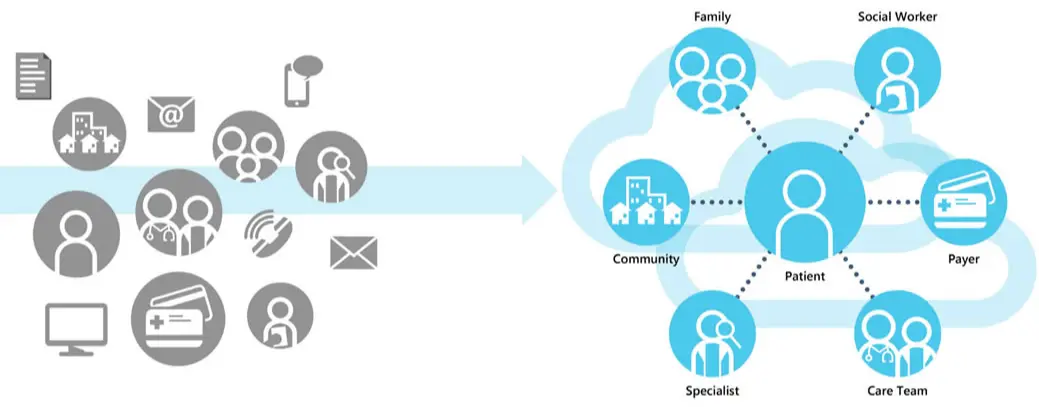
The Patient Engagement solutions ensure that your providers can share critical information in near-real time while reducing the wait for patients to be connected to the next clinician.
Patient engagement in healthcare is no longer about care delivered at discrete points in time. These solutions create a continuous feedback loop for your providers and their patients—inside and outside of care facilities.
Through devices like bedside tablets, patients can explore content tailored to their condition. Clinicians can use the same devices to access electronic health records and other hospital tools.

Image Description
The Operational Analytics solutions help you leverage available operational data to improve the delivery of care provided by your organization.
Operational intelligence can improve the quality of health care by using available data to help determine clinical and operational strategies. For example, operational analysis can be used to track patient bottlenecks in admission so that resources or processes can be adjusted accordingly to reduce wait times.
Employees can use operational analytics software to visualize data on the fly and graph trends in admissions, patient incidents, staff utilization, and other hospital operations. Predictive analytics using machine learning enables employees to use past data to predict future patterns. This enables employees to make better, more informed decisions.
Operational intelligence helps hospitals and healthcare organizations to streamline operations. For example, analytics can make meetings more efficient by allowing stakeholders to focus on solving problems rather than collecting data. Additionally, analytics can improve capabilities for preventing fraudulent activity, tracking payments, and dealing with improper payments.
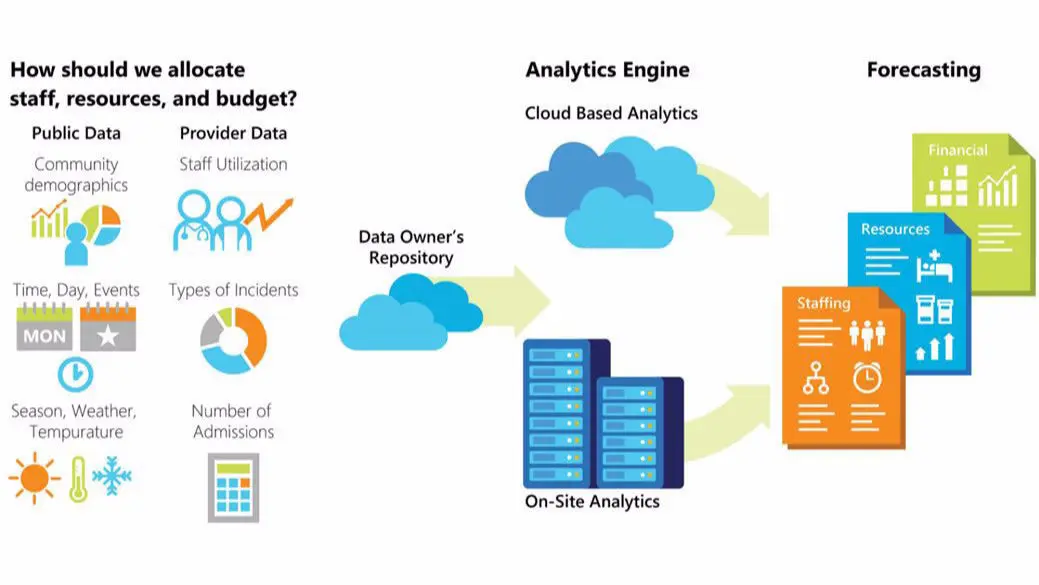
Operational Analytics solutions help healthcare organizations optimize hospital operations—and ultimately provide patients with better care. Operational analysis can help you allocate staff, resources, and budget.
You can pull in data from various sources—including community demographics and seasonal and calendar information—and correlate this with data about patients, incidents, admissions, and staff utilization. This enables you to track your current metrics, predict the future, and prescribe strategies for improvement.
Self-service BI and analytical tools enable onsite knowledge workers to manipulate data to suit their needs and visualize it instantly to get a better understanding of past operations. They can graph trends in areas like revenue and expenses over time, number of patients treated month over month, readmission rates, or number of hospital acquired infections by department.
Diagnostic analytics tools enable you to identify meaningful correlations in data from multiple sources. By using the processing power of machine learning in the cloud, you can move from analyzing the past to using predictive analytics to see where partial patterns in your data are headed.
Finally, prescriptive analytics go beyond predictive analytics to help you determine actionable operational strategies based on predictive models. By comparing patients with similar demographic characteristics and symptoms, prescriptive models can help to improve treatment results.
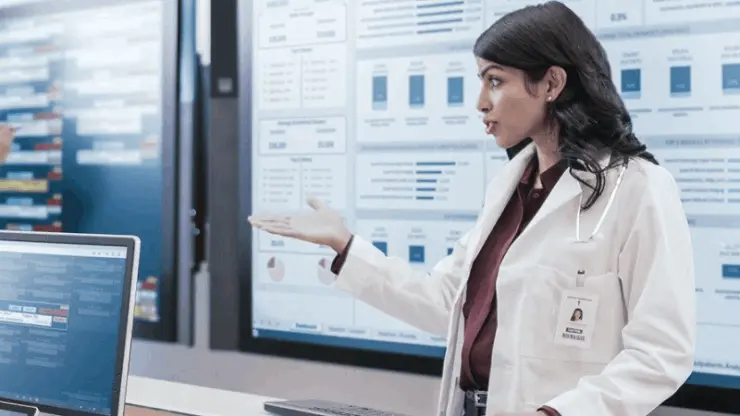
Clinical Analytics solutions improve clinical quality and health-related outcomes by allowing your clinicians and health professionals to utilize, share, and analyze structured and unstructured data.
Use clinical data analytics tools to support improved clinical operations and outcomes, as well as patient flow and satisfaction.
Streamline care delivery and achieve a true clinical transformation through enhanced processes. Enable your teams to use automated data summaries instead of having to program their own complex data queries.
Bring data types of multiple sizes together using various clinical data analytics tools in the cloud, on-premises, or in a hybrid environment.
Use clinical data analytics platforms to erase traditional boundaries around data, empowering care teams to convert data into actionable insights.

The Clinical Analytics solutions allow you to use the power of clinical informatics to synthesize data into actionable insights and achieve a true clinical transformation. Self-service healthcare analytics tools enable team members to easily get the information they need through dashboards, visualization, and alerts.
By using machine learning to process pooled data—from sources such as EMRs, smart medical devices, and demographics—you can use advanced predictive analytics to reveal hidden patterns that enable you to predict and mitigate chronic illness. These predictive analytics techniques are applicable to many scenarios in the healthcare sector.
The next step in Clinical Analytics is to move beyond these predictions by using prescriptive analytics, which allows you to create plans and strategies based on predictions. This use of big data leads to better outcomes to improve patient care.

The Care Coordination solutions enable you to communicate with patients, manage and connect health care providers, and monitor patient progress more effectively. Coordinated care solutions improve the quality of patient care services and reduce costs through workflow automation and optimization.
Allow health care teams and care coordinators to build better patient relationships through multi-channel communications, call centers, and self-service portals.
Provide case managers and care teams with automated workflows, measurement frameworks, and business processes that streamline health care services.
Use analytics to harness operational and patient data and optimize operations, inform patient care coordination and delivery decisions, and improve population health and disease management.
Enhance coordination of patient care services through collaboration and business process tools, enabling health care teams to more thoroughly understand patient needs.
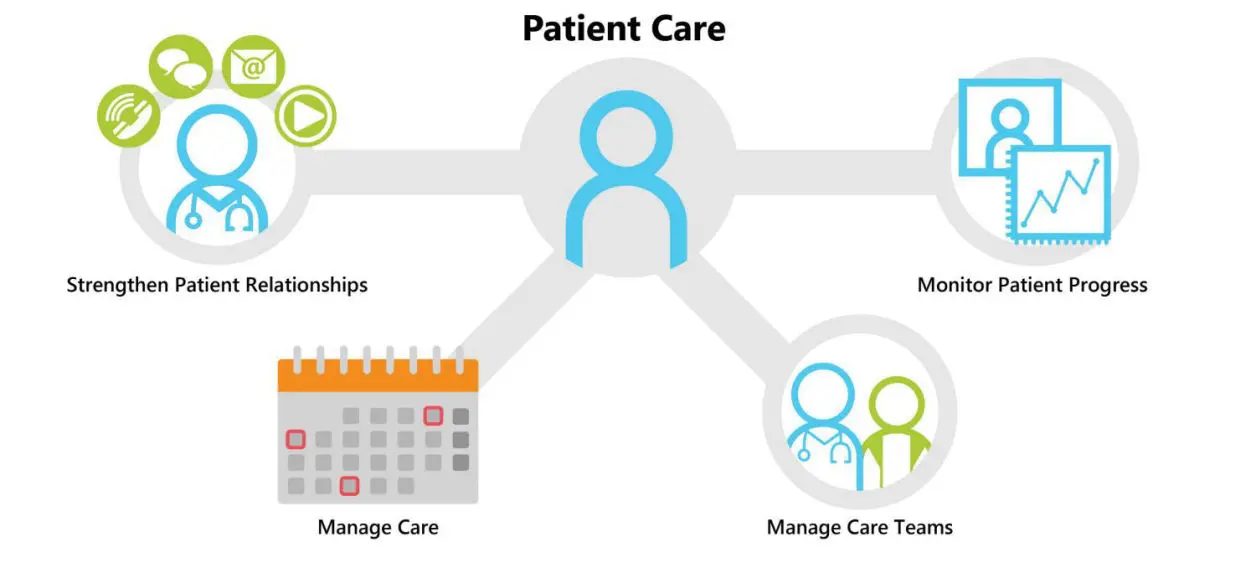
By leveraging an integrated platform, the Care Coordination solutions enable you and your organization to nurture ongoing patient relationships to keep patients on a path toward better health.
The solutions help your organization customize a health care management plan for each patient. They provide patient data analytics, goal tracking, and outcome reporting that patients and clinicians can see, as well as tracking utilization tools to improve the management of health care teams.
Care Coordination solutions bring together providers, patients, and patient data systems. You can use them to coordinate patient care through the use of mutually defined care plans that guide health care teams and ultimately benefit patients.
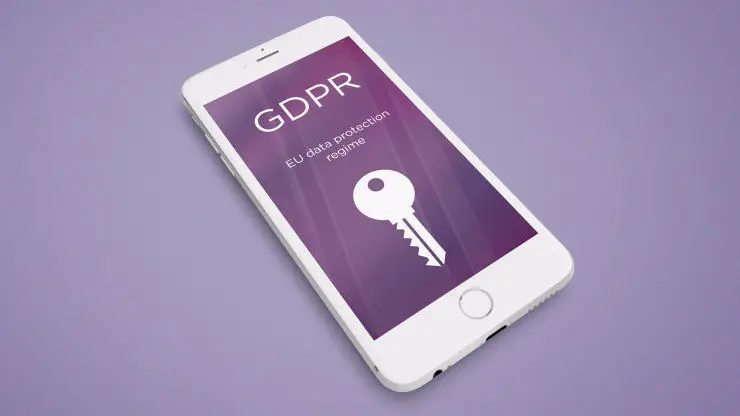
The Cybersecurity in Health solutions are trusted cloud solutions that help ensure that your healthcare organization’s data is managed, protected, and kept private in full compliance with the Health Insurance Portability and Accountability Act of 1996 (HIPAA) or other cybersecurity changes.
By using trusted technology tools—like HIPAA compliant video conferencing (or other cybersecurity changes)—help providers and patients make effective decisions about health issues.
Strengthening healthcare cybersecurity across operations harnesses trusted data from all sources and creates actionable insights.
Through secure collaboration and business process tools, teams can get a comprehensive view of patients—enhancing understanding of their health issues.
Help streamline care delivery by using secure, automated workflows and business processes.
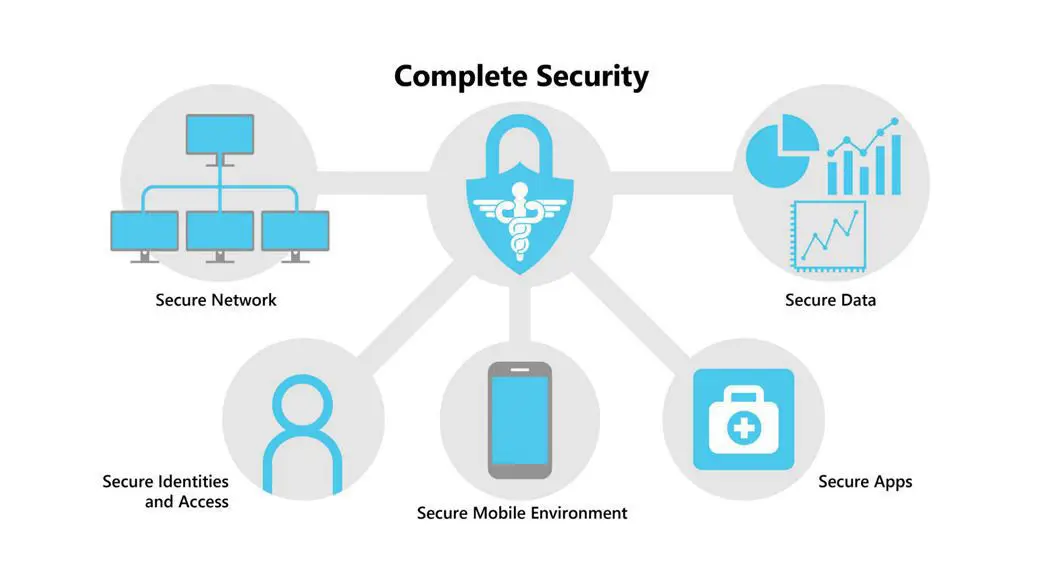
Image Description
Cybersecurity in Health solutions help you protect your network through advanced firewalls, packet inspection, antimalware programs, spam filters, and network isolation. The solutions offer controls for securing identity and access to corporate resources and data, while strengthening authentication.
Mobile device and app management ensures that devices connecting to your network follow HIPAA cybersecurity configurations. Threat modeling helps your custom apps adhere to secure development practices.
Lastly, the healthcare cybersecurity solutions give you encryption, rights management, and inspection capabilities for protecting your data within your network and in-transit.